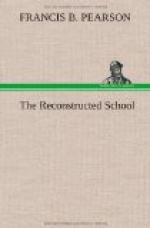Their whole bearing indicates that they are languid, morbid, misanthropic, and nerveless. They seem ill-nourished as well as mentally and spiritually starved. They seem the victims of inherited or acquired weaknesses that stamp them as belonging among the physically unfit. If the farmer should discover among his animals as large a percentage of unfitness and imperfection, he would reach the conclusion at once that something was radically wrong and would immediately set on foot well-thought-out plans to rectify the situation. But, seeing that these derelicts are human beings and not farm stock, we bestow upon them a sneer, or possibly a pittance by way of alms, and pass on our complacent ways. Looking upon the imperfect passersby, the observer is reminded of the tens of thousands of children who are defective in mind and body and are hidden away from public gaze, a charge upon the resources of the state.
Such a setting forth of the less agreeable side of present conditions would seem out of place, if not actually impertinent, were we inclined to ignore the fact that diagnosis must precede treatment. The surgeon knows full well that there will be pain, but he is comforted by the reflection that restoration to health will succeed the pain. We need to look squarely at the facts as they are in order to determine what must be done to avert a repetition in the future. We have seen the sins of the fathers visited upon the children to the third and fourth generation and still retained our complacency. We preach temperance to the young men of our day, but fail to set forth the fact that right living on their part will make for the well-being of their grandchildren. We exhibit our thoroughbred live stock at our fairs and plume ourselves upon our ability to produce stock of such quality. In the case of live stock we know that the present is the product of the past, but seem less ready to acknowledge the same fact as touching human animals. We may know that our ancestors planted thorns and yet we seem surprised that we cannot gather a harvest of grapes, and we would fain gather figs from a planting of thistles. But this may not be. We harvest according to the planting of our ancestors, and, with equal certainty, if we eat sour grapes the teeth of our descendants will surely be put on edge.
If we are to reconstruct our educational processes we must make a critical survey of the entire situation that we may be fully advised of the magnitude of the problem to which we are to address ourselves. We may not blink the facts but must face them squarely; otherwise we shall not get on. We may take unction to ourselves for our philanthropic zeal in caring for our unfortunates in penal and eleemosynary institutions, but that will not suffice. We must frankly consider by what means the number of these unfortunates may be reduced. If we fail to do this we convict ourselves of cowardice or impotence. We pile up our millions in buildings for the insane, the feeble-minded, the vicious, the epileptic, and plume ourselves upon our munificence. But if all these unfortunates could be redeemed from their thralldom, and these countless millions turned back into the channels of trade, civilization would take on a new meaning. Here is one of the problems that calls aloud to education for a solution and will not be denied.




